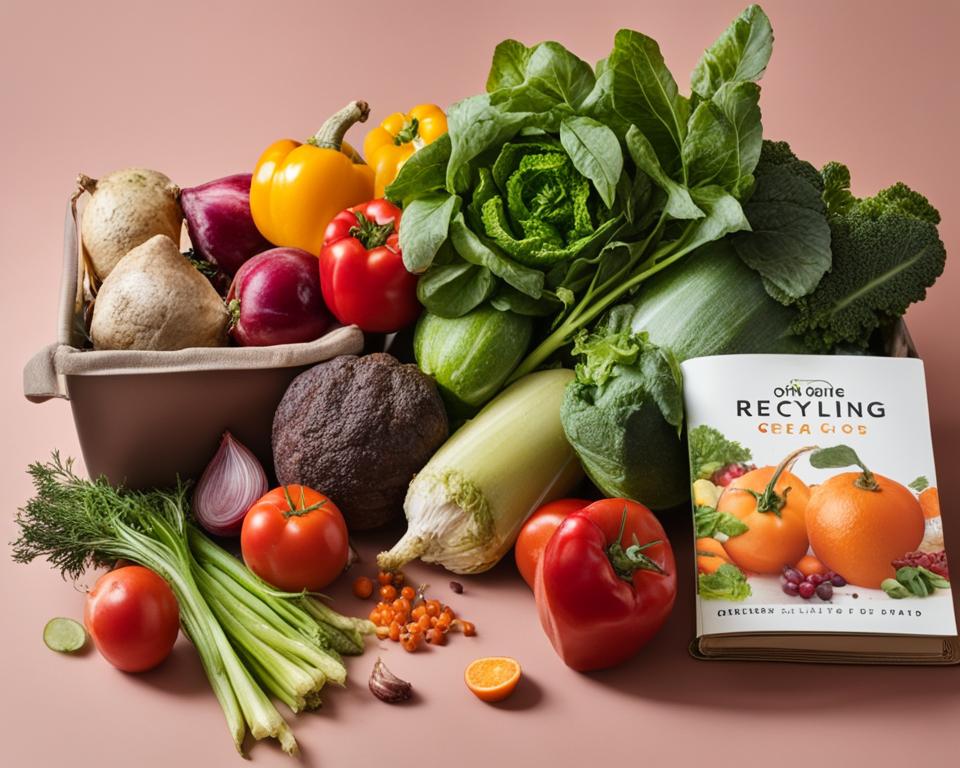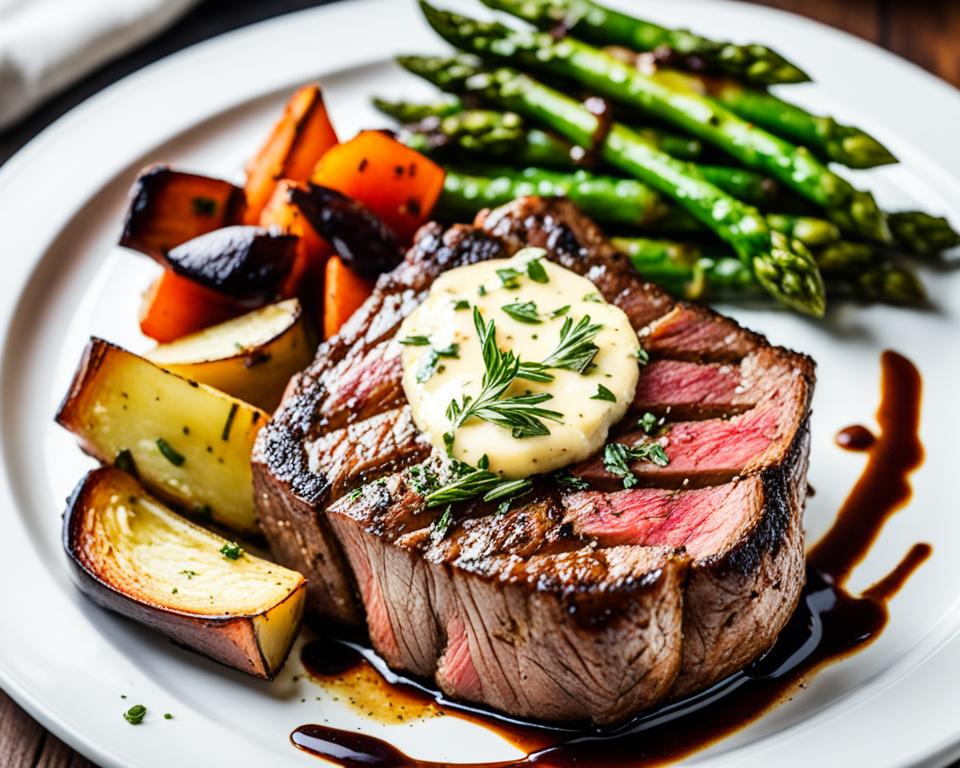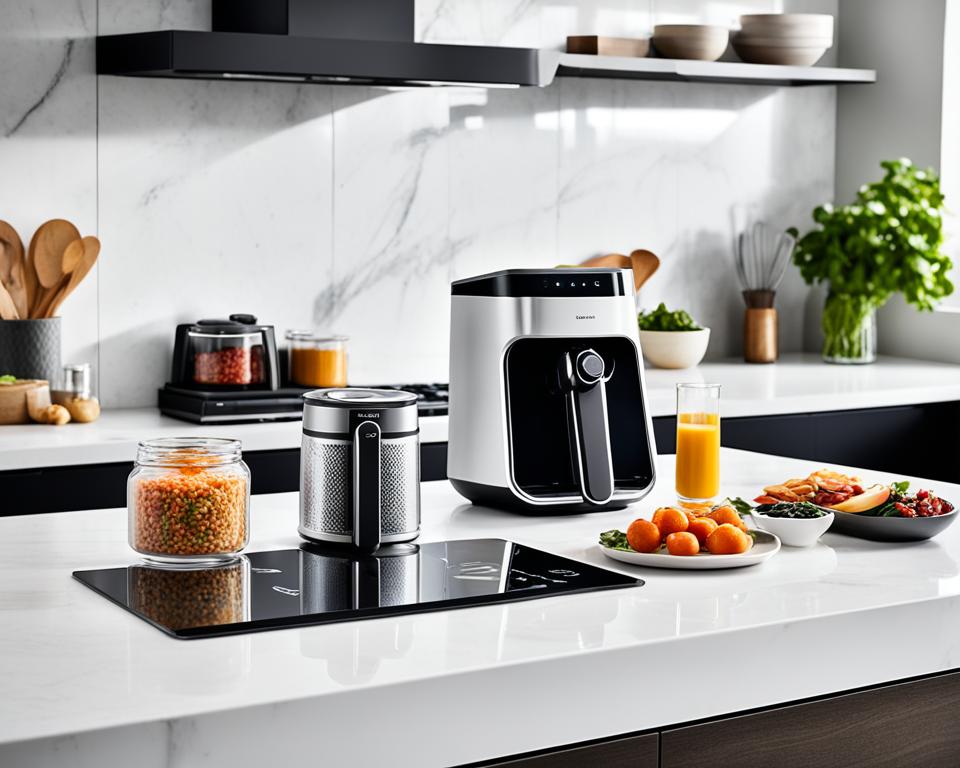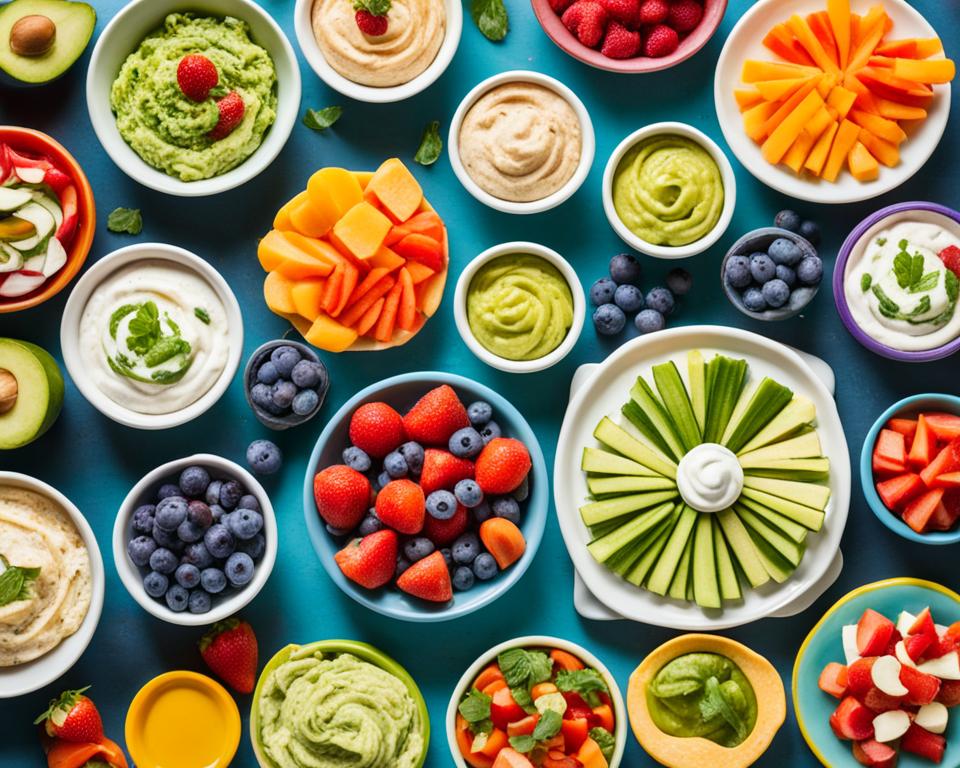Food waste is a significant issue in the United States, with the average American family throwing away over $2,000 worth of food every year. Not only is this wasteful, but it also has a negative impact on the environment. In this article, we will explore practical tips and strategies to help you reduce food waste while cooking on a budget. By implementing these budget-friendly ideas, you can save money and help the planet at the same time.
Key Takeaways:
- Plan your meals and create a grocery list to avoid buying unnecessary items.
- Store ingredients correctly to extend their shelf life.
- Cook ingredients with a shorter shelf life first to minimize waste.
- Get creative and repurpose leftovers to reduce food waste.
- Utilize your freezer to store leftovers and prevent spoilage.
Make a Meal Plan & Grocery List
One of the most effective ways to reduce food waste while cooking on a budget is to create a meal plan and a grocery list before you go shopping. By planning your meals in advance, you can avoid buying unnecessary items that may end up going bad and being thrown away. Take stock of what you already have in your kitchen before making your list to avoid purchasing duplicate ingredients. This simple step can help you minimize food waste and save money.
When making your meal plan, consider the ingredients you already have on hand and plan your meals around them. This way, you can use up items that are close to their expiration dates or that may spoil soon. Additionally, try to incorporate versatile ingredients that can be used in multiple meals throughout the week, such as chicken or canned beans.
Creating a grocery list based on your meal plan is essential to avoid impulse buying and unnecessary purchases. Stick to the items on your list and resist the temptation to buy items that you don’t need. By shopping with intention and planning ahead, you can reduce the amount of food that goes to waste.
Benefits of Making a Meal Plan & Grocery List
- Minimize food waste by only purchasing what you need
- Save money by avoiding impulse buys
- Reduce the number of grocery store trips
- Enjoy a well-balanced and nutritious diet
Example Meal Plan & Grocery List
Here’s an example of a meal plan and grocery list that can help you reduce food waste while cooking on a budget:
| Meal Plan | Grocery List |
|---|---|
| Monday: Chicken Stir-Fry with Rice | Chicken breast, mixed vegetables, rice |
| Tuesday: Black Bean Tacos | Canned black beans, tortillas, lettuce, tomatoes |
| Wednesday: Pasta with Tomato Sauce | Pasta, canned tomatoes, onion, garlic |
| Thursday: Vegetable Curry | Assorted vegetables, coconut milk, curry paste |
| Friday: Leftover Stir-Fry | Leftover chicken stir-fry from Monday |
By following this meal plan and purchasing only the items on the grocery list, you can ensure that each ingredient is used efficiently, minimizing waste and maximizing your budget.
Store Ingredients Correctly
Properly storing ingredients is essential for minimizing food waste. By following these food storage tips, you can extend the shelf life of your ingredients and reduce the likelihood of them going to waste.
The Fridge: Keeping it Fresh
When it comes to storing ingredients in the fridge, it’s important to keep a few things in mind. Meats should be stored on the bottom shelf to prevent any cross-contamination with other foods. This not only ensures food safety but also helps to preserve the quality of the meat. Fresh produce, on the other hand, should be placed in the vegetable drawer. By separating them from other items in the fridge, fruits and vegetables will stay fresh for longer.
“Proper food storage is essential for minimizing waste and keeping ingredients fresh.” – Martha Stewart
When organizing the vegetable drawer, make sure faster-spoiling items are placed on top for easy access. This ensures that they are used before they spoil. Utilizing airtight containers or bags can also help to maintain freshness and prevent odors from spreading.
Preserving Fresh Herbs
If you find that your herbs often go bad before you have a chance to use them, try storing them in a jar of water. Simply place the herbs, with the stems submerged in water, and cover them loosely with a plastic bag. This method helps to keep the herbs hydrated and fresh for a longer period of time.
Food Storage Tips:
- Separate meats and fresh produce in the fridge to prevent cross-contamination.
- Organize the vegetable drawer with faster-spoiling items on top.
- Store herbs in a jar of water to keep them fresh.
By implementing these food storage tips, you can reduce food waste and make the most of your ingredients.
Cook Ingredients with a Shorter Shelf Life First
When it comes to minimizing food waste and making the most of your ingredients, one effective strategy is to prioritize cooking ingredients with a shorter shelf life. By cooking the more perishable items earlier in the week, you can ensure they are used before they spoil, reducing waste and saving money in the process.
For example, vegetables like kale or chard have a shorter shelf life compared to hardy veggies like broccoli or carrots. By cooking the kale or chard earlier in the week and saving the broccoli and carrots for later, you can prevent the more delicate greens from going bad.
But how do you know which ingredients have a shorter shelf life? Use a produce shelf life guide to determine how long different items will stay fresh. This way, you can plan your meals accordingly and prioritize using up the ingredients that will spoil sooner.
By cooking ingredients with a shorter shelf life first, you can reduce food waste and ensure that no valuable ingredients go to waste. This simple strategy not only helps to minimize waste but also allows for more efficient meal planning and budgeting.
Cooking Ingredients with a Shorter Shelf Life First
| Ingredients | Shelf Life |
|---|---|
| Kale | 3-5 days |
| Chard | 3-5 days |
| Spinach | 3-5 days |
| Berries | 2-3 days |
| Herbs | 1-2 weeks |
Source: Shelf Life Guide for Produce
“By cooking the more perishable items earlier in the week, you can ensure they are used before they spoil, reducing waste and saving money in the process.”
Reuse the Remains of Ingredients
When it comes to reducing food waste, getting creative with using up the remains of ingredients is key. Don’t toss those vegetable trimmings and bones just yet – they can be stored in the freezer to make delicious homemade stock. Stale bread? Turn it into flavorful breadcrumbs or crispy croutons. Leftover zucchini? Use it to add bulk and flavor to a satisfying frittata. With a little imagination and resourcefulness, you can find endless possibilities for repurposing leftovers and reducing waste while adding variety to your meals.
Here are some creative cooking ideas to inspire you:
- Homemade stock: Store vegetable trimmings, such as onion peels, carrot ends, and celery leaves in a freezer bag. Add leftover bones from roasted chicken or beef to the mix. When you have enough, simmer them in water with some herbs and spices to create a flavorful stock to use as a base for soups, stews, and sauces.
- Breadcrumbs and croutons: Don’t let that stale bread go to waste. Toast it until crispy and then pulse it in a food processor to create fine breadcrumbs. Use them to coat chicken or fish for a crunchy texture, or sprinkle them on top of casseroles for added crunch. You can also cut the bread into cubes, toss them with some olive oil and seasoning, and bake them in the oven for homemade croutons to elevate your salads and soups.
- Vegetable frittata: Leftover vegetables like zucchini, bell peppers, or mushrooms can be the star of a delicious frittata. Simply sauté them with some onions and garlic, beat some eggs with a splash of milk, pour it over the vegetables, and cook until set. Add some cheese or herbs for extra flavor. It’s a versatile dish that can be enjoyed for breakfast, lunch, or dinner.
Remember, these are just a few examples of how you can repurpose leftovers and reduce food waste. The key is to think outside the box and explore new possibilities with the ingredients you have on hand. Don’t be afraid to experiment and have fun in the kitchen!
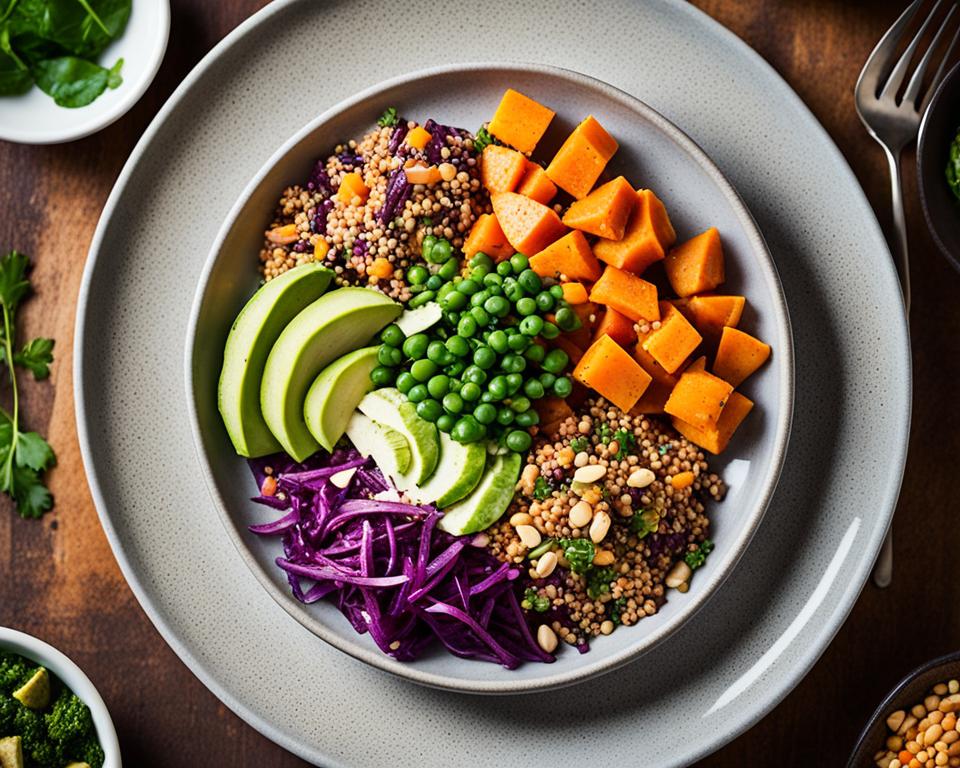
Turn Leftovers into New Meals
Repurposing leftovers is a fun and creative way to transform them into delicious and interesting meals. Instead of letting your leftovers go to waste, you can give them a new life and enjoy exciting flavors. Here are some creative ideas to repurpose your leftovers and reduce food waste:
- Leftover meat sauce: Turn your leftover meat sauce into tasty tacos by adding some fresh toppings like shredded lettuce, diced tomatoes, and a dollop of sour cream.
- Plain rice: Transform plain rice into a flavorful fried rice by sautéing it with your choice of vegetables, protein (such as diced chicken or shrimp), and soy sauce.
- Slow-cooked meat: Use your slow-cooked meat leftovers, like pulled pork or shredded beef, to create mouthwatering sandwiches, hearty salads, or satisfying burritos.
- Leftover veggies and proteins: Stir-frying is an excellent technique for using up leftover veggies and proteins. Toss them in a hot pan with some soy sauce, garlic, and ginger for a quick and tasty meal.
By getting inventive with your leftovers and trying out new recipes, you can turn them into exciting meals without letting anything go to waste. Repurposing leftovers not only saves you money but also contributes to reducing food waste and promoting sustainable cooking practices. Your taste buds and the environment will thank you!
Utilize the Freezer
The freezer is our ally in reducing food waste. If we have leftovers that we won’t be able to eat before they spoil, let’s freeze them for later use. Meats, produce, and even fully prepared meals can be frozen, allowing us to extend their shelf life and avoid waste. By utilizing our freezer effectively, we can ensure that no food goes to waste.
Benefits of Freezing Leftovers
- Minimizes Food Waste: Freezing leftovers prevents them from spoiling and ultimately ending up in the trash. It allows us to fully utilize the food we have and reduces waste.
- Saves Time and Money: By freezing extra portions, we can save time on future meal preparation. It also helps us save money by allowing us to buy ingredients in larger quantities or take advantage of bulk deals without worrying about them going to waste.
- Increases Meal Variety: With a freezer stocked with frozen leftovers, we have a variety of options available for quick and convenient meals. We can easily defrost and reheat dishes, making mealtime hassle-free.
Remember to label and date your frozen leftovers to keep track of what’s inside. You can use freezer-safe containers or wrap food tightly in aluminum foil or freezer bags.
Check out this image to see how freezing leftovers can help reduce food waste:
Now that we know how beneficial the freezer can be, let’s explore other ways to reduce food waste while cooking on a budget.
Conclusion
In conclusion, reducing food waste while cooking on a budget is not only beneficial for your wallet but also for the environment. By implementing simple yet effective strategies, such as making a meal plan, storing ingredients correctly, and repurposing leftovers, you can significantly minimize waste and save money.
Creating a meal plan and grocery list before shopping helps you avoid buying unnecessary items, reducing the chances of food going bad and being thrown away. Storing ingredients correctly, such as placing fresh produce in the vegetable drawer and meats on the bottom shelf, extends their shelf life.
Repurposing leftovers and turning them into new meals not only prevents waste but also adds variety to your menu. Additionally, utilizing your freezer to freeze leftovers and cooking in larger batches can help save time, money, and reduce food waste.
By implementing these strategies and embracing a little planning and creativity, you can enjoy eco-conscious, cost-saving meals while minimizing food waste in your kitchen. So let’s make a positive impact on our environment and our budget by reducing food waste on a budget!
FAQ
How can I reduce food waste while cooking on a budget?
By implementing simple strategies like making a meal plan, storing ingredients correctly, and repurposing leftovers, you can significantly minimize waste and save money.
How do I make a meal plan and grocery list?
Before you go shopping, plan your meals in advance and take stock of what you already have in your kitchen. This way, you can avoid buying unnecessary items and reduce food waste.
What are some food storage tips to minimize waste?
Store meats on the bottom shelf of the fridge to prevent cross-contamination. Place fresh produce in the vegetable drawer, with faster-spoiling items on top for easy access. Storing herbs in a jar of water can also help them stay fresh longer.
What should I cook first to minimize food waste?
Prioritize cooking ingredients with a shorter shelf life first, such as kale or chard. By using these perishable items earlier in the week, you can ensure they are used before they spoil.
How can I repurpose leftovers to minimize waste?
Get creative by using vegetable trimmings and bones to make homemade stock, turning stale bread into breadcrumbs or croutons, or using leftover zucchini to bulk up a frittata. The possibilities are endless!
What are some ways to turn leftovers into new meals?
Leftover meat sauce can be transformed into tacos, plain rice can become fried rice, and slow-cooked meat can be used for sandwiches, salads, or burritos. Stir-frying is also a great way to use up leftover veggies and proteins.
How can I utilize the freezer to reduce food waste?
If you have leftovers that you won’t be able to eat before they spoil, freeze them for later use. Meats, produce, and even fully prepared meals can be frozen. Cooking in larger batches and freezing extra portions can save you time, money, and reduce food waste.
What are the key takeaways for reducing food waste on a budget?
By making a meal plan, storing ingredients correctly, cooking perishable items first, repurposing leftovers, utilizing the freezer, and getting creative with your cooking, you can minimize food waste and save money while cooking on a budget.

